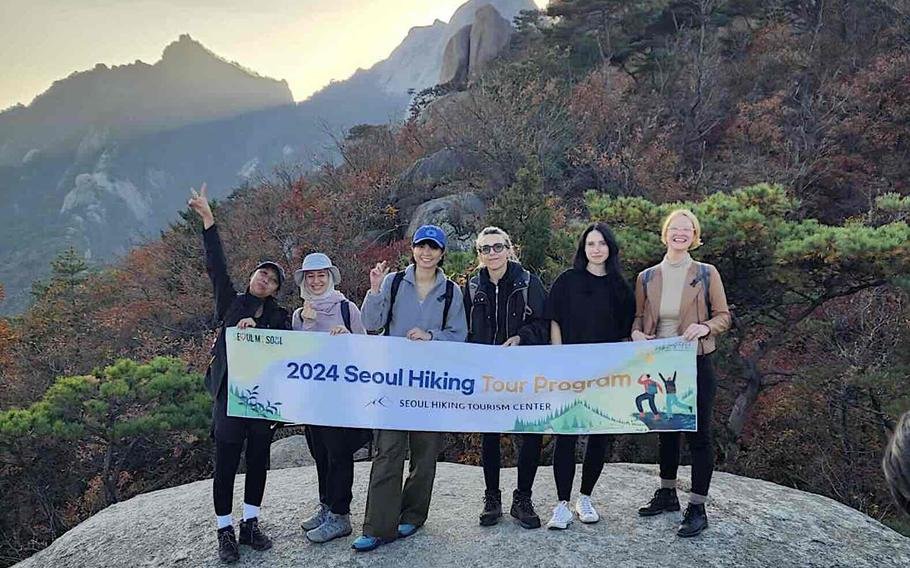With 70% mountains and hills, Hiking has always been one of the favourite sport and habits in South Korea. The unique joy of hiking that Koreans have long known slurping ramen and eating gimbap at the peak and cooling down with makgeolli after a trek is now catching on among foreigners as well. One key reason behind it’s growing popularity is the ease and spontaneity it offers to tourist they can enjoy scenic hike surrounded by nature without leaving the city or preparing much at all. The idea of urban hiking, where hikers can reach a mountain just by taking a bus or subway, feels fresh and novel to visitors from abroad.
Catalina a traveller for Romania said “ In korea, it's so easy to go climb mountains. In my country we have very high mountains, but we don't have infrastructure. So in order to go there you actually have to take car and then hiking is going to take you at least one weekend. You cannot just wake up one morning decide that you want to go hiking, take a subway and hike”.
The Seoul hiking tourism centre first opened its Bukhan San branch in 2022, it’s Bugaksan branch the following year and most recently it’s Gwanaksan branch this year, now operating three centres in total. As of Tuesday, over 95,000 people have used the centres more than 26,000 of them foreign nationals. While the Gwanaksan centre primarily serves Korean hikers the Bugaksan centre now see foreign visitors making up nearly 50% of its total foot traffic. At the Bukhan San branch, that figure is even higher, at close to 70%. “when the Bukhan San canter first opened three years ago, we thought it was remarkable if the ratio of foreigners to locals was even 50:50 but now, foreigners are overwhelmingly out number locals at the Bukhan San centre. More than two-third of our visitors are foreigners” said Lee chan-ho, an official of Seoul tourism Organization.
These centres serve as both information hubs and rest stops for those seeking out Seoul’s urban mountains. In addition to multilingual service in English, Japanese and more, they offer affordable rental of hiking equipment such as boots, clothing and walking sticks, with fees ranging from 2000 won to 5000 won. The centres are also equipped with lockers, visitors lounges and showers. According to the global booking platform k look, sales of hiking and trekking to Korea’s famous mountains increased by more than 120% in 2024 compared to the previous year.
Mount Gwanak:- (629 meters) near Gwanaksan station on the William line, boasts of its rugged beauty, forming part of the Korean capital's southern border with Gyeonggi province. Unlike some of Seoul’s gentler mountains, mount Gwanak has diverse routes, from steep ascents to winding paths, and is renowned for its dramatic granite peaks and unique rock formation, which create picturesque scenery. This mountain is home to several historic temples and hermitage, such as Yeonjuam hermitage and Gwacheon Hyanggyo confusion school, adding a cultural and spiritual dimension to the hiking experience.
Mount Bugak:- (342 meters), located near Anguk station an Gyeongbokgung station on Seoul metro line 3 can be a great starter for casual visitors to enjoy the natural beauty and historical ambiance with in the heart of a bustling metropolis as of the main guardian mountains of seoul’s inner four mountains during the 1392-1910 Nose on dynasty, it offers a unique opportunity to hike along sections of the ancient Seoul city wall, providing a tangible link to korea's past. Hikers are rewarded with stunning vistas of downtown Seoul, encompassing iconic landmark like Gyeongbok palace, Cheongwadae ( the former presidential compound) and N Seoul tower.
Mount Bukhan:- with its highest peak at 836 meters, is a highly accessible yet rugged mountain located conveniently near Bukhan San Ui station on the Ui LTR. It is a particularly popular destination for hiker due to its accessibility and the variety of courses it offers. While some trails provide gentle walks with excellent city views, others cater to those seeking a more adventurous or even entered hiking experience. The mountain also boasts a rich historical and cultural heritage, with numerous temples fortresses and ancient sites nestted within the slopes.
- Reported by Kanta Kumari
Intern at the Korean Academy
Korean news analysis and reporting


